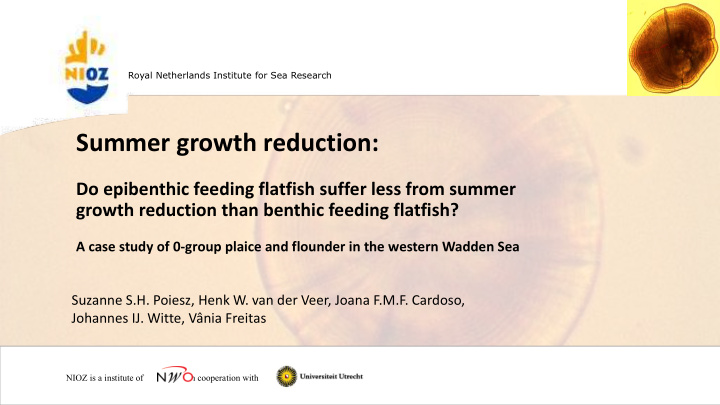



Royal Netherlands Institute for Sea Research Summer growth reduction: Do epibenthic feeding flatfish suffer less from summer growth reduction than benthic feeding flatfish? A case study of 0-group plaice and flounder in the western Wadden Sea Suzanne S.H. Poiesz, Henk W. van der Veer, Joana F.M.F. Cardoso, Johannes IJ. Witte, Vânia Freitas NIOZ is an institute of , in cooperation with NIOZ is a institute of in cooperation with
Life cycle flatfishes 0-group juveniles 0-group plaice and flounder in the Western Wadden Sea 2
Summer growth reduction History • Decline in activity of benthos after summer + growth model 3
Summer growth reduction History Observed growth vs max. predicted growth Starting point: Freitas et al. 2012 Summer growth reduction - Various flatfish species - Various locations 4
Summer growth reduction in flatfishes Explanation for plaice: Supported by De Vlas, 1979, food intake Balgzand Less benthic prey in stomach Possible causes: Stomach content analysis of plaice 5
Summer growth reduction Explanation for plaice – less food available Production Activity Benthic feeder Spring Summer Autumn
Hypothesis: Test: benthic versus epibenthic feeders • Decline in activity of benthos after summer Plaice Growth reduction? YES Flounder Growth reduction? NO Spring Summer Autumn 7
Summer growth reduction Hasn’t it already been done? Freitas et al 2012: Summer growth reduction - Various locations - Various flatfish species - No difference between plaice and flounder But: Calculation was based on population growth 8
Summer growth reduction ? Hasn’t it already been done? (Size-selective migration / mortality ? Growth reduction ? Mean length 60 mm Mean length 80 mm Solution? 9
Solution: Individual growth Individual growth predictions based on otoliths microstructure analysis Benthic plaice Epibenthic flounder 10
Oto tolith mi microstru ructure analysis Freq. for different cohorts Sampling data Length + Age in days = For each cohort Settlement date Number of daily rings (Age) Length - age Plaice or flounder observations 11
Growth predictions: DEB model DEB model: - One model for all species - Species specific parameters Maximum growth predictions - Temperature - Size Growth trajectories F DEB parameters M Water temperature 12
Summer growth comparsion: Hypothesis F M + = Otolith readings: DEB simulation (growth Relative growth ratios: - Length – age relationship trajectories): - Observed / (mean F and M ) - Various cohorts 13 - Females and Males
Results Benthic (plaice) versus epibenthic (flounder) feeder Epibenthic feeding flounder Benthic feeding plaice 1995 1995 1.50 1.50 1.00 1.00 Realized growth of flounder Realized growth of Plaice 0.50 0.50 0.00 0.00 0 50 100 150 200 250 300 60 90 120 150 180 210 240 270 1996 1996 1.5 1.50 1 1.00 0.5 0.50 0 0.00 0 50 100 150 200 250 300 60 90 120 150 180 210 240 270 Confirming hypothesis 14
Summer growth reduction Conclusions • Hypothesis confirmed: • • Benthic feeder (slight) growth reduction Epibenthic feeder no growth reduction • Growth predictions based on individual growth: less prominent • Summer growth reduction based on population growth: biased (Emigration, Immigration, Size selective predation??) 15
Summer growth reduction Conclusions • Possible next steps: • Use a fully benthic species (Sole) 16
Thank you for listening. 17
Recommend
More recommend